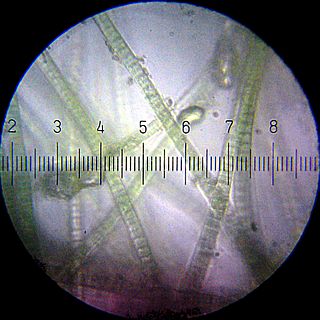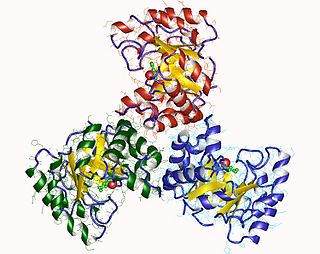
The citric acid cycle —also known as the Krebs cycle, Szent-Györgyi-Krebs cycle or the TCA cycle (tricarboxylic acid cycle)—is a series of chemical reactions to release stored energy through the oxidation of acetyl-CoA derived from carbohydrates, fats, and proteins. The Krebs cycle is used by organisms that respire (as opposed to organisms that ferment) to generate energy, either by anaerobic respiration or aerobic respiration. In addition, the cycle provides precursors of certain amino acids, as well as the reducing agent NADH, that are used in numerous other reactions. Its central importance to many biochemical pathways suggests that it was one of the earliest components of metabolism. Even though it is branded as a 'cycle', it is not necessary for metabolites to follow only one specific route; at least three alternative segments of the citric acid cycle have been recognized.
Hydrolase is a class of enzymes that commonly perform as biochemical catalysts that use water to break a chemical bond, which typically results in dividing a larger molecule into smaller molecules. Some common examples of hydrolase enzymes are esterases including lipases, phosphatases, glycosidases, peptidases, and nucleosidases.

Biological carbon fixation or сarbon assimilation is the process by which inorganic carbon is converted to organic compounds by living organisms. The compounds are then used to store energy and as structure for other biomolecules. Carbon is primarily fixed through photosynthesis, but some organisms use a process called chemosynthesis in the absence of sunlight.

Oxaloacetic acid (also known as oxalacetic acid or OAA) is a crystalline organic compound with the chemical formula HO2CC(O)CH2CO2H. Oxaloacetic acid, in the form of its conjugate base oxaloacetate, is a metabolic intermediate in many processes that occur in animals. It takes part in gluconeogenesis, the urea cycle, the glyoxylate cycle, amino acid synthesis, fatty acid synthesis and the citric acid cycle.

The enzyme citrate synthase E.C. 2.3.3.1 ] exists in nearly all living cells and stands as a pace-making enzyme in the first step of the citric acid cycle. Citrate synthase is localized within eukaryotic cells in the mitochondrial matrix, but is encoded by nuclear DNA rather than mitochondrial. It is synthesized using cytoplasmic ribosomes, then transported into the mitochondrial matrix.
In enzymology, an acetylpyruvate hydrolase (EC 3.7.1.6) is an enzyme that catalyzes the chemical reaction

In enzymology, a phosphonoacetate hydrolase (EC 3.11.1.2) is an enzyme that catalyzes the chemical reaction

The enzyme citrate (pro-3S)-lyase catalyzes the chemical reaction
In enzymology, a 2-(acetamidomethylene)succinate hydrolase (EC 3.5.1.29) is an enzyme that catalyzes the chemical reaction
In enzymology, a 2-(hydroxymethyl)-3-(acetamidomethylene)succinate hydrolase (EC 3.5.1.66) is an enzyme that catalyzes the chemical reaction
In enzymology, a 4-acetamidobutyrate deacetylase (EC 3.5.1.63) is an enzyme that catalyzes the chemical reaction
In enzymology, an acetylornithine deacetylase (EC 3.5.1.16) is an enzyme that catalyzes the chemical reaction
In enzymology, an acetylputrescine deacetylase (EC 3.5.1.62) is an enzyme that catalyzes the chemical reaction
In enzymology, an acetylspermidine deacetylase (EC 3.5.1.48) is an enzyme that catalyzes the chemical reaction
In enzymology, an arylalkyl acylamidase (EC 3.5.1.76) is an enzyme that catalyzes the chemical reaction
In enzymology, a chitin deacetylase (EC 3.5.1.41) is an enzyme that catalyzes the chemical reaction
In enzymology, a N-acetyl-beta-alanine deacetylase (EC 3.5.1.21) is an enzyme that catalyzes the chemical reaction
In enzymology, a N-acetyldiaminopimelate deacetylase (EC 3.5.1.47) is an enzyme that catalyzes the chemical reaction
In enzymology, a (S)-N-acetyl-1-phenylethylamine hydrolase (EC 3.5.1.85) is an enzyme that catalyzes the chemical reaction
Cobalt-precorrin 5A hydrolase (EC 3.7.1.12), CbiG (gene)) is an enzyme with systematic name cobalt-precorrin 5A acylhydrolase. This enzyme catalyses the following chemical reaction






